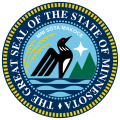| |||||||||||||||||
| |||||||||||||||||
| |||||||||||||||||
The 1873 Minnesota Secretary of State election was held on November 4, 1873, in order to elect the Secretary of State of Minnesota. Republican nominee and incumbent Secretary of State Samuel P. Jennison defeated Democratic nominee and former member of the Minnesota Senate John H. Stevens. [1]


